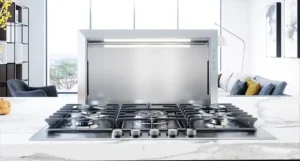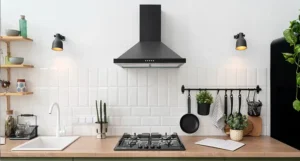As an inseparable part of the kitchen, which you are going to use all the time, you might want to learn the amp requirement of the range hood you are going to use in your kitchen. And it’s only fair to ask since a lot of things like the need for a breaker and circuit type depend on the amp requirements of your range hood.
So, how many amps does a 600 CFM range hoo use? Well, most range hoods use amps anywhere from 3 to 7 amps. However, the actual amp usage will largely depend on your exact model as well as the type of motor that your range hood is using.
In this article, we’ll discuss how many amps a 600 CFM range hood typically uses, whether it’s costly to operate, the amperage of the breaker required, and whether it needs a dedicated circuit. Additionally, we’ll explore how the amperage may vary among different models and address frequently asked questions related to range hood electrical usage.
How to Determine the Amperage a 600 CFM Range Hood Uses?
A range hood’s electrical consumption is typically measured in amperes (amps), and it can vary from one model to another. To determine the amperage of a specific 600 CFM range hood, you should refer to the manufacturer’s specifications or find a label on the hood itself. On average, range hoods draw between 1 to 5 amps, but it’s essential to confirm the exact rating for your model.
Find the Power Rating (Watts)
Look for a label or tag on the range hood that provides its power rating in watts. It’s usually specified in the product manual or on the product itself. Let’s say, for example, the range hood is rated at 300 watts.
Determine the Voltage (Volts)
Most residential electrical systems in the United States operate on 120 volts. However, it’s essential to verify the voltage in your specific location, as it might be different in other countries. Let’s assume it’s 120 volts in this example.
Calculate the Amperage
Use the formula of Amperage (A) = Power (W) / Voltage (V) to calculate the amperage:
Amperage (A) = Power (W) / Voltage (V)
Amperage (A) = 300 watts / 120 volts
Amperage (A) = 2.5 amps
So, if you have 300 watts of power and 120 volts of voltage of your 600 CFM range hood, then the amperage is 2.5 amps.
Is Operating a 600 CFM Range Hood Costly in Terms of Electricity?
The operating cost of a 600 CFM range hood primarily depends on how often you use it and your local electricity rates. Generally, range hoods are not considered power-hungry appliances, and their energy consumption is relatively low compared to other kitchen appliances like stoves and ovens.
Let’s calculate a rough estimate of the electricity cost for operating a 600 CFM range hood:
Wattage: The wattage of a range hood can vary, but it’s typically in the range of 100-300 watts.
Usage: Suppose you use the range hood for one hour per day. That’s 0.3 kWh (300 watts * 1 hour).
Electricity Rate: Assume an electricity rate of $0.12 per kWh.
Cost per Day: 0.3 kWh * $0.12/kWh = $0.036
Cost per Month (30 days): $0.036 * 30 = $1.08
Operating a 600 CFM range hood for an hour each day would cost approximately $1.08 per month. This cost is relatively low and shouldn’t significantly impact your electricity bill.
How Many Amps Breaker Is Needed for a 600 CFM Range Hood?
To determine the amperage of the breaker required for your 600 CFM range hood, you should consider the manufacturer’s specifications. As mentioned earlier, these range hoods typically draw between 1 to 5 amps. To ensure safety and proper operation, it’s advisable to install a breaker that can handle the maximum amperage your range hood may require. A 15-amp circuit breaker is commonly used for residential kitchen appliances, but it’s essential to consult an electrician for the best guidance specific to your setup.
Does a 600 CFM Range Hood Need a Dedicated Circuit?
Whether a 600 CFM range hood requires a dedicated circuit depends on the electrical load in your kitchen and local building codes. In some cases, a dedicated circuit may be recommended or even required to prevent overloading existing circuits. Here are a few factors to consider:
Existing Electrical Load
Evaluate the existing electrical appliances in your kitchen. If you have other high-power appliances like an electric range or wall oven, it might be advisable to install a dedicated circuit for your range hood to ensure there are no issues with circuit overloads.
Local Building Codes
Check with your local building codes and regulations. Some codes may stipulate that certain kitchen appliances, including range hoods, must be on dedicated circuits for safety and code compliance.
Consult an Electrician
To make an informed decision, it’s best to consult with a licensed electrician who can assess your kitchen’s electrical setup and recommend the most appropriate solution.
Variation in Amperage Among Different Models
The amperage of a range hood can vary based on several factors, including the design, motor power, and additional features. Here’s a breakdown of how amperage may vary among different models:
Basic Models
Basic 600 CFM range hoods with simple controls and standard motors typically draw around 1 to 2 amps.
High-Power Models
Range hoods with powerful motors designed for heavy-duty cooking environments may draw 3 to 5 amps.
Variable Speed and Additional Features
Range hoods with variable speed settings, built-in lighting, and advanced features may have slightly higher amperage due to the added functionality.
When choosing a model, consider your cooking habits and needs to determine whether a basic model or one with additional features is the best fit for your kitchen.
Frequently Asked Questions (FAQs)
Can I install a 600 CFM range hood on an existing circuit?
It’s possible to install a 600 CFM range hood on an existing circuit if the circuit has enough capacity to accommodate the additional load. However, it’s recommended to consult an electrician to assess your electrical setup and ensure it meets safety and code requirements.
Are there energy-efficient range hoods available?
Yes, some range hood models are designed to be energy-efficient. Look for models with energy-efficient motors and LED lighting, as they can help reduce electricity consumption.
What’s the difference between ducted and ductless range hoods in terms of electrical usage?
Ducted range hoods, which vent air to the outside may be more energy-efficient in the long run because they don’t have to work as hard to remove cooking pollutants. Ductless range hoods, which recirculate filtered air back into the kitchen, may consume slightly more electricity due to the operation of the internal fan and filters.
How can I reduce the electricity consumption of my range hood?
To minimize electricity usage, consider using the range hood only when necessary, cleaning the filters regularly to maintain optimal airflow, and opting for an energy-efficient model with LED lighting.
To Sum Up
A 600 CFM range hood typically uses between 1 to 5 amps, depending on the model. Operating costs are relatively low, and the need for a dedicated circuit depends on your kitchen’s existing electrical load and local building codes. When choosing a range hood, consider the amperage, as well as additional features that may affect energy consumption. Always consult with an electrician for proper installation and to ensure compliance with safety standards and codes.


![Read more about the article [Explained] Which Kitchen Chimney Is Better Filter Or Filterless?](https://kitchenhoodcare.com/wp-content/uploads/2023/09/which-kitchen-chimney-is-better-filter-or-filterless-300x161.webp)
